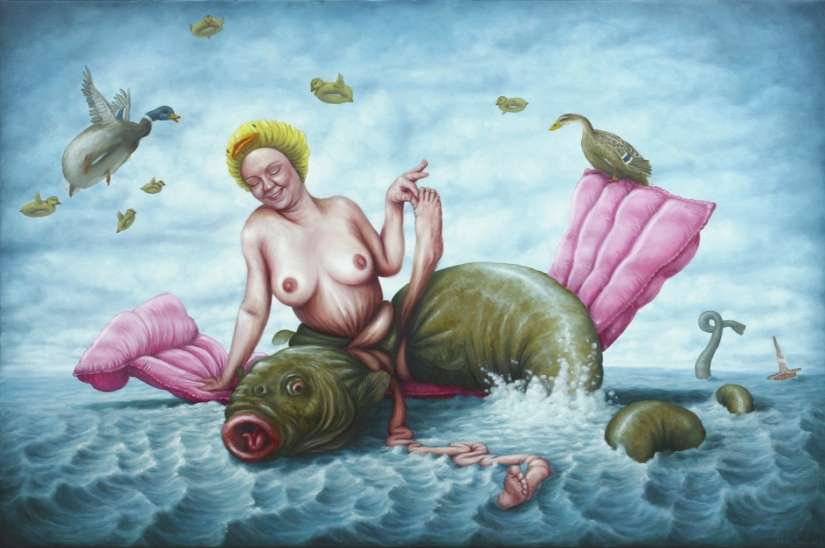Alternative Reality by Bruno Pontiroli
Categories: Culture | Social Networks
By Pictolic https://pictolic.com/article/alternative-reality-by-bruno-pontiroli.htmlBruno Pontiroli is a French surrealist artist whose goal is to turn our narrow vision of the world upside down and disrupt our imagination by shaking the generally accepted reality with images that are as understandable as they are familiar. Distorting the symbol or mixing opposite universes allows Pontiroli to question the identity of things so that he can reinvent them.

One fine day, a self-taught artist from Paris, Bruno Pontiroli, felt the need to transfer to canvas the absurd and strange reality living in his imagination. He calls himself a dreamer living on a cloud that a plane crashes into. And its goal is to turn upside down our usual narrow perception of the world and awaken our own imagination.

In the early years of his career, Pontiroli belonged to the guild of street artists and painted graffiti on metro trains in Paris and in all major European countries. By his admission, it was a fun period in his life.

Today, Bruno Pontiroli creates surreal worlds inhabited by fantastic characters - centaurs, mermaids and other creatures that contradict all the laws of nature. In his poetic and mysterious paintings, we see how the incredible becomes reality. Pontiroli brings to life all our childhood dreams and gives us a new look at the world.

Striving to turn the narrow vision of the world upside down, Bruno creates paintings that adorn quite understandable and familiar images from childhood.
Like a child sculpting out of clay or assembling a construction kit, Bruno Pontiroli starts with easily recognizable animals. Then he forms and transforms a simple image of a nimble lion or hare into a kind of new reality.

Bruno's paintings are realistic depictions of unreal scenes. Although some of his paintings are dark and disturbing, others are funny and playful. So why are his canvases so disturbing to viewers?
The objects depicted in the paintings, most viewers have doubts about the normality of the artist. Many believe that he clearly has a perverted idea of animals and people, so very often his surreal paintings are unacceptable in the real world. But Bruno Pontiroli continues to maintain his style in all his works.

Many people call his work surrealism, but Pontiroli does not like "labels": after all, his work has no boundaries, and his works push the boundaries of reality and beauty in art.

A fan of Rene Magritte, Roland Topor, Rubens and Rembrandt, he finds inspiration in the situations, books and images that surround him. A simple photo of a camel can become the basis for a new picture.

It usually combines two or more unknown universes and creates something stranger than the usual fiction. In all his surreal paintings, he uses the same character, but riding on different animals. Moreover, most animals are depicted in a distorted form.

A wrinkled hippopotamus balances on its tongue, a tiger bends its trunk at a 90-degree angle, and a hyena rotates its hind legs in the air — all this is a world in which a different logic reigns. By mixing opposite universes and distorting symbols, he creates his own space of absurdity and paradoxes.

Pontiroli created this world and his works from his fairy-tale dreams. Everything is alive here, from an airplane that crashes into clouds to snowmen that model a human body from skin scales.


The artist simultaneously brings to life our childhood dreams and a new view of the world. He likes to depict animals. They are constantly in his mind. From his fairy-tale visions, he conjures up surreal and fantastic universes where centaurs cut off the heads of half-human half-horses, overly impatient people can hug a large walrus or jump on twisted giraffes.


How does an artist work? First, he writes down all his ideas in a notebook, good or bad, and makes a sketch in pencil, watercolor or ink. One idea usually becomes the central theme of a new painting, and the master uses some others to build the surrounding universe.

The next step is a sketch on paper confirming the overall composition. At the end, he continues to paint on canvas, which for him consists of two stages: first black and white acrylic, and then oil and color.




Recent articles

If your mailbox is located outside, this is the first thing that catches your eye when someone comes to your door, whether it's the ...

There is nothing more dangerous in life than a beautiful girl and the weapon she holds in her hands. Be careful and vigilant, as ...

Many people believe that the lists of the most wanted criminals include only terrorists or heads of drug cartels. In fact, this is ...